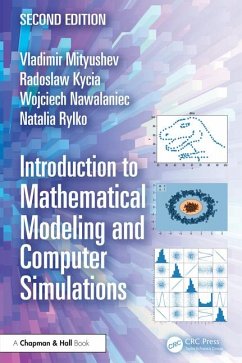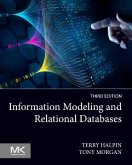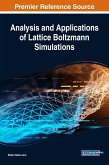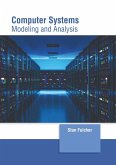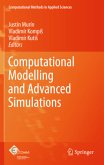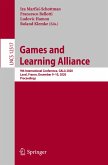Vladimir Mityushev, Radoslaw Antoni Kycia, Wojciech Nawalaniec, Natalia Rylko
Introduction to Mathematical Modeling and Computer Simulations
Vladimir Mityushev, Radoslaw Antoni Kycia, Wojciech Nawalaniec, Natalia Rylko
Introduction to Mathematical Modeling and Computer Simulations
- Gebundenes Buch
- Merkliste
- Auf die Merkliste
- Bewerten Bewerten
- Teilen
- Produkt teilen
- Produkterinnerung
- Produkterinnerung
This book continues to serve as an engaging and accessible textbook for undergraduates studying mathematical modeling and computer simulations. The book is heavily focussed on applications, and so may have a particular appeal to applied mathematicians, engineers, and others working in applied quantitative disciplines.
Andere Kunden interessierten sich auch für
![Information Modeling and Relational Databases Information Modeling and Relational Databases]() Terry HalpinInformation Modeling and Relational Databases142,99 €
Terry HalpinInformation Modeling and Relational Databases142,99 €![Analysis and Applications of Lattice Boltzmann Simulations Analysis and Applications of Lattice Boltzmann Simulations]() Analysis and Applications of Lattice Boltzmann Simulations258,99 €
Analysis and Applications of Lattice Boltzmann Simulations258,99 €![A Short Statement of Some Important Facts Relative to the Late Election of a Mathematical Professor in the University of Edinburgh: Accompanied With O A Short Statement of Some Important Facts Relative to the Late Election of a Mathematical Professor in the University of Edinburgh: Accompanied With O]() Dugald StewartA Short Statement of Some Important Facts Relative to the Late Election of a Mathematical Professor in the University of Edinburgh: Accompanied With O34,99 €
Dugald StewartA Short Statement of Some Important Facts Relative to the Late Election of a Mathematical Professor in the University of Edinburgh: Accompanied With O34,99 €![Computer Systems: Modeling and Analysis Computer Systems: Modeling and Analysis]() Computer Systems: Modeling and Analysis154,99 €
Computer Systems: Modeling and Analysis154,99 €![Computational Modelling and Advanced Simulations Computational Modelling and Advanced Simulations]() Computational Modelling and Advanced Simulations77,99 €
Computational Modelling and Advanced Simulations77,99 €![Games and Learning Alliance Games and Learning Alliance]() Games and Learning Alliance66,99 €
Games and Learning Alliance66,99 €![Games and Learning Alliance Games and Learning Alliance]() Games and Learning Alliance85,99 €
Games and Learning Alliance85,99 €-
-
-
This book continues to serve as an engaging and accessible textbook for undergraduates studying mathematical modeling and computer simulations. The book is heavily focussed on applications, and so may have a particular appeal to applied mathematicians, engineers, and others working in applied quantitative disciplines.
Hinweis: Dieser Artikel kann nur an eine deutsche Lieferadresse ausgeliefert werden.
Hinweis: Dieser Artikel kann nur an eine deutsche Lieferadresse ausgeliefert werden.
Produktdetails
- Produktdetails
- Verlag: CRC Press
- 2nd edition
- Seitenzahl: 330
- Erscheinungstermin: 20. Dezember 2024
- Englisch
- Abmessung: 234mm x 156mm x 21mm
- Gewicht: 667g
- ISBN-13: 9781032661513
- ISBN-10: 1032661518
- Artikelnr.: 71588268
- Herstellerkennzeichnung
- Libri GmbH
- Europaallee 1
- 36244 Bad Hersfeld
- gpsr@libri.de
- Verlag: CRC Press
- 2nd edition
- Seitenzahl: 330
- Erscheinungstermin: 20. Dezember 2024
- Englisch
- Abmessung: 234mm x 156mm x 21mm
- Gewicht: 667g
- ISBN-13: 9781032661513
- ISBN-10: 1032661518
- Artikelnr.: 71588268
- Herstellerkennzeichnung
- Libri GmbH
- Europaallee 1
- 36244 Bad Hersfeld
- gpsr@libri.de
Vladimir Mityushev is currently a Professor and leads the research group Materialica+ at the Cracow University of Technology. His expertise encompasses mathematical modeling, computer simulations, and industrial mathematics. He has provided a complete solution to the Riemann-Hilbert problem for multiply connected domains, applying it to the analytical theory of representative volume elements for dispersed composites. His interdisciplinary research spans a wide array of fields, including the effective properties of composites with deterministic and random structures, elliptic partial differential equations, symbolic computations, boundary value problems, asymptotic methods, packing, deterministic and random graphs, biomathematics, bioinformatics, porous media, permeability, diffusion, elasticity, heat conduction, fracture mechanics, electroosmotic phenomena, and viscous flow in wavy channels. Rados¿aw Antoni Kycia, PhD, MBA, earned his PhD from Theoretical Physics from Jagiellonian University. He specializes in multidisciplinary projects involving Computer Science, Mathematics, and Physics. He collaborated with CERN, Brookhaven National Laboratory, and Masaryk University. He is the Head of the Computer Science Department at the Faculty of Computer Science and Telecommunications of the Cracow University of Technology. Wojciech Nawalaniec is a specialist in Computer Simulations and Applied Mathematics. His research focuses on the effective properties of random composites. He developed a computationally efficient symbolic-numerical algorithm to determine structural sums defined by an exponential complexity algorithm. He derived new higher-order formulas for the effective constants of dispersed composites. In addition to symbolic-numerical calculations, his scientific activity also involves simulations and the analysis of random structures using machine learning methods. Wojciech Nawalaniec currently works in the industry, exploring applications of AI in cyber risk quantification. Natalia Rylko pursued her Doctorate in Technical Sciences, specializing in Mechanics and Thermomechanics of Fiber Composite Materials, at Poznan University of Technology. She currently serves as the Vice Dean of the Department of Computer Science and Telecommunications at the Cracow University of Technology, where she is actively involved in educational and scientific endeavors. Her research in Materials Engineering focuses on applying advanced mathematical techniques, machine learning, and analyzing large datasets, including intricate composite material structures depicted in images.
I. General Principles and Methods. 1. Principles of Mathematical Modeling.
1.1. How to develop a mathematical model. 1.2. Types of models. 1.3.
Stability of models. 1.4. Dimension, units, and scaling. 2. Numerical and
symbolic computations. 2.1. Numerical and symbolic computations of
derivatives and integrals. 2.2. Iterative methods. 2.3. Newton's method.
2.4. Method of successive approximations. 2.5. Banach Fixed Point Theorem.
2.6. Why is it difficult to numerically solve some equations? Exercises and
mini-projects. II. Basic Applications. 3. Application of calculus to
classic mechanics. 3.1. Mechanical meaning of the derivative. 3.2. Integral
and energy. 3.3. Potential energy. 3.4. Interpolation. 3.5. Integration of
discrete functions. Exercises and mini-projects. 4. Ordinary differential
equations and their applications. 4.1. Principle of transition for ODE.
4.2. Radioactive decay. 4.3. Logistic differential equation and its
modifications. 4.4. Time delay. 4.5. Approximate solution to differential
equations. 4.6. Harmonic oscillation. 4.7. Lotka-Volterra model. 4.8.
Linearization. Exercises and mini-projects. 5. Stochastic models. 5.1.
Method of least squares. 5.2. Fitting. 5.3. Method of Monte Carlo. 5.4.
Random walk. Exercises and mini-projects. 6. One-dimensional stationary
problems. 6.1. 1D geometry. 6.2. Second order equations. 6.3. 1D Green's
function. 6.4. Green's function as a source. 6.5. The ¿-function. III.
Advanced Applications. 7. Vector analysis. 7.1. Euclidean space R3. 7.2.
Scalar, vector and mixed products. 7.3. Rotation of bodies. 7.4. Scalar,
vector, and mixed product in Mathematica. 7.5. Tensors. 7.6. Scalar and
vector fields. 7.7. Integral theorems. Exercises and mini-projects. 8. Heat
equations. 8.1. Heat conduction equations. 8.2. Initial and boundary value
problems. 8.3. Green's function for the 1D heat equation. 8.4. Fourier
series. 8.5. Separation of variables. 8.6. Discrete approximations of PDE.
8.7. Universality in Mathematical Modeling Table. Exercises and
mini-projects. 9. Asymptotic methods in composites. 9.1. Principle of
Asymptotology. 9.2. Effective properties of composites. 9.3. Principles of
homogenization theory. 9.4. Maxwell's approach. 9.5. Mathematical modeling
and effective properties of composites. 9.6. Strategy of investigations.
9.7. Densely packed balls. Exercises and mini-projects. 10. Machine
learning and data analysis. 10.1. Supervised, unsupervised learning, and
regression. 10.2. Data storage. 10.3. A simple example of classification
problem. 10.4. Reading, cleaning and scaling data. 10.5. Simple statistics.
10.6. Dimensionality reduction by PCA. 10.7. Selected models of supervised
learning. 10.8. Selected models of unsupervised learning. 10.9. Regression.
10.10. Neural Networks. A. Introduction to Python.
1.1. How to develop a mathematical model. 1.2. Types of models. 1.3.
Stability of models. 1.4. Dimension, units, and scaling. 2. Numerical and
symbolic computations. 2.1. Numerical and symbolic computations of
derivatives and integrals. 2.2. Iterative methods. 2.3. Newton's method.
2.4. Method of successive approximations. 2.5. Banach Fixed Point Theorem.
2.6. Why is it difficult to numerically solve some equations? Exercises and
mini-projects. II. Basic Applications. 3. Application of calculus to
classic mechanics. 3.1. Mechanical meaning of the derivative. 3.2. Integral
and energy. 3.3. Potential energy. 3.4. Interpolation. 3.5. Integration of
discrete functions. Exercises and mini-projects. 4. Ordinary differential
equations and their applications. 4.1. Principle of transition for ODE.
4.2. Radioactive decay. 4.3. Logistic differential equation and its
modifications. 4.4. Time delay. 4.5. Approximate solution to differential
equations. 4.6. Harmonic oscillation. 4.7. Lotka-Volterra model. 4.8.
Linearization. Exercises and mini-projects. 5. Stochastic models. 5.1.
Method of least squares. 5.2. Fitting. 5.3. Method of Monte Carlo. 5.4.
Random walk. Exercises and mini-projects. 6. One-dimensional stationary
problems. 6.1. 1D geometry. 6.2. Second order equations. 6.3. 1D Green's
function. 6.4. Green's function as a source. 6.5. The ¿-function. III.
Advanced Applications. 7. Vector analysis. 7.1. Euclidean space R3. 7.2.
Scalar, vector and mixed products. 7.3. Rotation of bodies. 7.4. Scalar,
vector, and mixed product in Mathematica. 7.5. Tensors. 7.6. Scalar and
vector fields. 7.7. Integral theorems. Exercises and mini-projects. 8. Heat
equations. 8.1. Heat conduction equations. 8.2. Initial and boundary value
problems. 8.3. Green's function for the 1D heat equation. 8.4. Fourier
series. 8.5. Separation of variables. 8.6. Discrete approximations of PDE.
8.7. Universality in Mathematical Modeling Table. Exercises and
mini-projects. 9. Asymptotic methods in composites. 9.1. Principle of
Asymptotology. 9.2. Effective properties of composites. 9.3. Principles of
homogenization theory. 9.4. Maxwell's approach. 9.5. Mathematical modeling
and effective properties of composites. 9.6. Strategy of investigations.
9.7. Densely packed balls. Exercises and mini-projects. 10. Machine
learning and data analysis. 10.1. Supervised, unsupervised learning, and
regression. 10.2. Data storage. 10.3. A simple example of classification
problem. 10.4. Reading, cleaning and scaling data. 10.5. Simple statistics.
10.6. Dimensionality reduction by PCA. 10.7. Selected models of supervised
learning. 10.8. Selected models of unsupervised learning. 10.9. Regression.
10.10. Neural Networks. A. Introduction to Python.
I. General Principles and Methods. 1. Principles of Mathematical Modeling.
1.1. How to develop a mathematical model. 1.2. Types of models. 1.3.
Stability of models. 1.4. Dimension, units, and scaling. 2. Numerical and
symbolic computations. 2.1. Numerical and symbolic computations of
derivatives and integrals. 2.2. Iterative methods. 2.3. Newton's method.
2.4. Method of successive approximations. 2.5. Banach Fixed Point Theorem.
2.6. Why is it difficult to numerically solve some equations? Exercises and
mini-projects. II. Basic Applications. 3. Application of calculus to
classic mechanics. 3.1. Mechanical meaning of the derivative. 3.2. Integral
and energy. 3.3. Potential energy. 3.4. Interpolation. 3.5. Integration of
discrete functions. Exercises and mini-projects. 4. Ordinary differential
equations and their applications. 4.1. Principle of transition for ODE.
4.2. Radioactive decay. 4.3. Logistic differential equation and its
modifications. 4.4. Time delay. 4.5. Approximate solution to differential
equations. 4.6. Harmonic oscillation. 4.7. Lotka-Volterra model. 4.8.
Linearization. Exercises and mini-projects. 5. Stochastic models. 5.1.
Method of least squares. 5.2. Fitting. 5.3. Method of Monte Carlo. 5.4.
Random walk. Exercises and mini-projects. 6. One-dimensional stationary
problems. 6.1. 1D geometry. 6.2. Second order equations. 6.3. 1D Green's
function. 6.4. Green's function as a source. 6.5. The ¿-function. III.
Advanced Applications. 7. Vector analysis. 7.1. Euclidean space R3. 7.2.
Scalar, vector and mixed products. 7.3. Rotation of bodies. 7.4. Scalar,
vector, and mixed product in Mathematica. 7.5. Tensors. 7.6. Scalar and
vector fields. 7.7. Integral theorems. Exercises and mini-projects. 8. Heat
equations. 8.1. Heat conduction equations. 8.2. Initial and boundary value
problems. 8.3. Green's function for the 1D heat equation. 8.4. Fourier
series. 8.5. Separation of variables. 8.6. Discrete approximations of PDE.
8.7. Universality in Mathematical Modeling Table. Exercises and
mini-projects. 9. Asymptotic methods in composites. 9.1. Principle of
Asymptotology. 9.2. Effective properties of composites. 9.3. Principles of
homogenization theory. 9.4. Maxwell's approach. 9.5. Mathematical modeling
and effective properties of composites. 9.6. Strategy of investigations.
9.7. Densely packed balls. Exercises and mini-projects. 10. Machine
learning and data analysis. 10.1. Supervised, unsupervised learning, and
regression. 10.2. Data storage. 10.3. A simple example of classification
problem. 10.4. Reading, cleaning and scaling data. 10.5. Simple statistics.
10.6. Dimensionality reduction by PCA. 10.7. Selected models of supervised
learning. 10.8. Selected models of unsupervised learning. 10.9. Regression.
10.10. Neural Networks. A. Introduction to Python.
1.1. How to develop a mathematical model. 1.2. Types of models. 1.3.
Stability of models. 1.4. Dimension, units, and scaling. 2. Numerical and
symbolic computations. 2.1. Numerical and symbolic computations of
derivatives and integrals. 2.2. Iterative methods. 2.3. Newton's method.
2.4. Method of successive approximations. 2.5. Banach Fixed Point Theorem.
2.6. Why is it difficult to numerically solve some equations? Exercises and
mini-projects. II. Basic Applications. 3. Application of calculus to
classic mechanics. 3.1. Mechanical meaning of the derivative. 3.2. Integral
and energy. 3.3. Potential energy. 3.4. Interpolation. 3.5. Integration of
discrete functions. Exercises and mini-projects. 4. Ordinary differential
equations and their applications. 4.1. Principle of transition for ODE.
4.2. Radioactive decay. 4.3. Logistic differential equation and its
modifications. 4.4. Time delay. 4.5. Approximate solution to differential
equations. 4.6. Harmonic oscillation. 4.7. Lotka-Volterra model. 4.8.
Linearization. Exercises and mini-projects. 5. Stochastic models. 5.1.
Method of least squares. 5.2. Fitting. 5.3. Method of Monte Carlo. 5.4.
Random walk. Exercises and mini-projects. 6. One-dimensional stationary
problems. 6.1. 1D geometry. 6.2. Second order equations. 6.3. 1D Green's
function. 6.4. Green's function as a source. 6.5. The ¿-function. III.
Advanced Applications. 7. Vector analysis. 7.1. Euclidean space R3. 7.2.
Scalar, vector and mixed products. 7.3. Rotation of bodies. 7.4. Scalar,
vector, and mixed product in Mathematica. 7.5. Tensors. 7.6. Scalar and
vector fields. 7.7. Integral theorems. Exercises and mini-projects. 8. Heat
equations. 8.1. Heat conduction equations. 8.2. Initial and boundary value
problems. 8.3. Green's function for the 1D heat equation. 8.4. Fourier
series. 8.5. Separation of variables. 8.6. Discrete approximations of PDE.
8.7. Universality in Mathematical Modeling Table. Exercises and
mini-projects. 9. Asymptotic methods in composites. 9.1. Principle of
Asymptotology. 9.2. Effective properties of composites. 9.3. Principles of
homogenization theory. 9.4. Maxwell's approach. 9.5. Mathematical modeling
and effective properties of composites. 9.6. Strategy of investigations.
9.7. Densely packed balls. Exercises and mini-projects. 10. Machine
learning and data analysis. 10.1. Supervised, unsupervised learning, and
regression. 10.2. Data storage. 10.3. A simple example of classification
problem. 10.4. Reading, cleaning and scaling data. 10.5. Simple statistics.
10.6. Dimensionality reduction by PCA. 10.7. Selected models of supervised
learning. 10.8. Selected models of unsupervised learning. 10.9. Regression.
10.10. Neural Networks. A. Introduction to Python.

